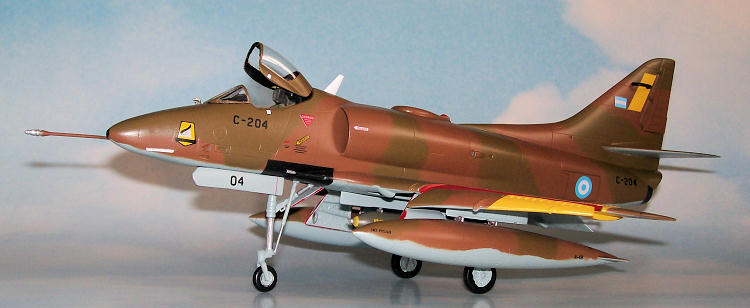
Hobbycraft 1/48 A-4B Skyhawk "C-204"
| KIT #: | HC 1433 |
| PRICE: | CAD$25.00 MSRP |
| DECALS: | Several options |
| REVIEWER: |
Pablo Calcaterra |
| NOTES: | Aerocalcas # 48011 decals used |

| HISTORY |
(One before) Last Skyhawk Down
Historical Background:
The last Skyhawk lost in combat in
the history of this noble plane was a Kuwaiti Scooter lost during the first Gulf
War.
C-204 was the last Skyhawk shot down
before the Kuwaiti one. It happened during the 1982 war against
This A4-B took part in the following
missions:
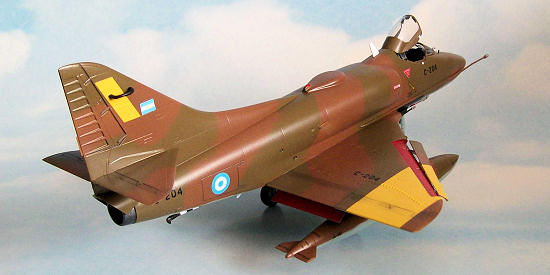 May 21st,
1982
May 21st,
1982
OF 1189: MULA call sign, each
plane armed with a Mk-17 bomb (1,000 lb). Capt Pablo Carballo (C-204), Lt Carlos
Rinke (C-231), 1st Lt. Carlos
Cachon (C-250), Ensg Leonardo Carmona (C-214). They took off from
While refueling from a KC-130, C-250
experienced technical problems and without being able to top up the tanks,
Cachon was forced to return to his base.
Shortly afterwards, the planes
started to fly very low over the sea (20 to 30 mts above the surface). Suddenly
MULA 2 broke the mandatory radio silence and told his leader that there was a
problem and that the fuel was not transferring normally from the drop tanks.
Carballo ordered him sharply: “Return!” But Rinke wanted to continue, though he
knew that his chances of returning to the base were now slim. He insisted: “Sir,
I want to press on!” to which Carballo answered: “I command you to return”. As a
consequence, Rinke broke formation and returned to
As they started to fly over land,
the cloud cover started to increase to a point that they were forced to turn
right as they were running the risk of crashing against the hills (between 600
and 800 mt.). Suddenly they appeared over Estrecho de
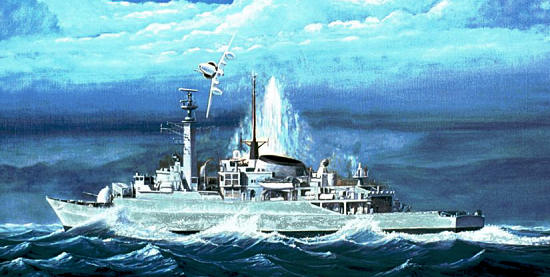 Carballo,
now alone, was flying north following the East coast of the sound. Suddenly he
broke into
Carballo,
now alone, was flying north following the East coast of the sound. Suddenly he
broke into 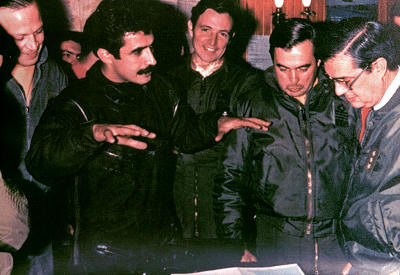 explaining
his attack to HMS Ardent to the Commander of the AAF, Lami Dozo. Behind him are
(l to r) Capt. Varela, Vicecomodoro Mariel, Vicecomodoro Zini
explaining
his attack to HMS Ardent to the Commander of the AAF, Lami Dozo. Behind him are
(l to r) Capt. Varela, Vicecomodoro Mariel, Vicecomodoro Zini
May 25th:
OF 1237, call sign
May 28th:
OF 1254, call sign CUNA, armed with
3 x 125 kg bombs. Capt. Carlos Varela in C-204, Ensg Moroni, Lt. Roca. Their
target was a ship that was attacking BAM Darwin / Goose Green during the ground
combats for that location. They took off from Rio Gallegos, refueled from a
KC-130 but found bad weather and were unable to locate their target. They
returned without contacting the enemy.
June 8th:
IMPORTANT NOTE: There are
important discrepancies among the actors of this air combat. The actions told
hereby are as described by each protagonist, but sometimes they don’t match the
perspective of the other witnesses. You can draw your own conclusions.
After the successful attack to
the ship unloading troops in Bluff Cove in what was later called the Darkest Day
of the Task Force (Sir Galahad destroyed, Sir Tristam and HMS Plymouth seriously
damaged by A4-Bs and IAI Daggers), the Argentine Air Force decided to send a 2nd
wave to further damage the troops or ships in the area. The V Brigada component
was sent into action following
OF 1296: MAZO call sign. 1st
Lt Danilo Bolzan (C-204), Ensg Guillermo Dellepiane (C-239), Lt Juan Arraras
(C-226). Bolzan had volunteered to return to action (he was an instructor at the
Air Force Academy in Cordoba) and this was his second mission in the war after
some refreshment sessions in the Vta Brigada Aerea in San Luis (first mission
had been the day before when a section he was part of failed to find an enemy
ship)
OF 1297: MARTILLO section. 1st
Lt O. Berrier (C-212), Ensg Alfredo Vazquez (C-228), 1st
Lt Hector Sanchez (C-231)
Berrier returned with problems in
his oxygen supply just before the in flight refuel, while Dellepiane’s plane
experienced problems in his engine (
At the same time, flying in a
racetrack circuit over Choiseul Sound and protecting mutually their tales, Flt.
Lt. Dave Morgan (in ZA177) and Lt. David Smith (in XZ499) from HMS Hermes 800
Sqn were watching Foxtrot 4 (from Fearless) sailing towards the coast with a
load of soldiers and a Land Rover. The sun was setting and they only had 4
minutes left of fuel before they had to return to their “Mother” for their first
land in the dark. Their patrol had lasted at this point 40 minutes.
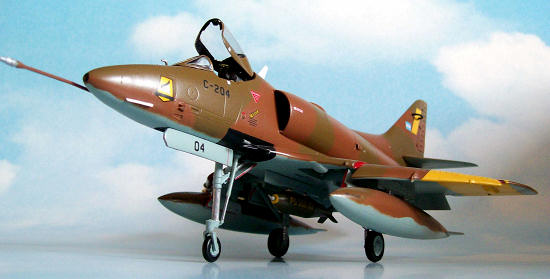 The
controller in Puerto Argentino told the Skyhawks that their objective was
further to the West. In the turn, Vazquez surpassed Sanchez who accelerated to
overtake #4 and get back in position.
The
controller in Puerto Argentino told the Skyhawks that their objective was
further to the West. In the turn, Vazquez surpassed Sanchez who accelerated to
overtake #4 and get back in position.
Bolzan saw the landing craft Foxtrot
4 from Fearless and turned sharply right towards it. So tight was the turn that
1,2 and 4 crossed in front of Sanchez and he was forced to jump over them again,
gaining height. Now he was positioned behind and to one side of his formation.
Morgan suddenly saw a plane very
low approaching his protégé. It was Bolzan.
He called Smith on the radio: “Four Mirages below.
Follow me down!” Smith at that point was giving his back to Foxtrot 4 so he
reversed violently his turn and dove to the sea. He had lost track of Morgan who
was diving at 600 knots towards Bolzan. At that moment, Sanchez look behind and
to his left and saw splashes in the sea. Morgan got close to the Skyhawks a
little bit too late, as the first Argentine plane dropped his bombs. Apparently
these fell 100 yards beyond the landing craft though one of the bombs dropped by
Bolzan could have hit Foxtrot’s bow. Arraras attacked in turn and hit the ship
squarely with his 3 bombs. Morgan at that moment realized that there was not
only a second enemy but also a third (Vazquez), who were flying parallel to him
on his left. He suspended his chase of Arraras, turned left and fired a missile
to Vazquez who was closer to him.
Something called Sanchez attention
to his right. He looked in that direction and saw a couple of Harriers at the
same height and 500 meters to his 3 o’clock that at that moment were firing
their Sidewinders. Sanchez only had time to warn his friends: ”Break! Missile in
the air! Two Harriers!” Bolzan broke south while Arraras and Vazquez turned
north. Things happened really fast. In that small fraction of time, the missiles
had eaten half the distance to the Argentine planes.
Arraras saw the missile chasing him
and reversed his course to apparently force the missile to run for a longer
distance and run out of fuel. But the Sidewinder followed his movements, cut
into his turn and exploded close to his tail. The Skyhawk seemed to be
untouched, gained height and Arraras ejected. The nose and wings fell to the
sea. The other missile entered the exhaust pipe of Vazquez plane, which
disintegrated in a fiery explosion that killed the pilot instantly. Suddenly, in
front of his windshield, Morgan found a parachute with the pilot hanging from it
like a rag doll, arms and legs extended. The ejection had been successful but it
seems that Arraras was either dead or had passed out due to the violence of the
hit with the air or any other injury provoked in the explosion. He was never
seen after he fell in the water. Some versions claim that his parachute was also
partially on fire.
Shocked by what he had just
witnessed, the death of two of his friends, Sanchez did not do anything for some
seconds. When he
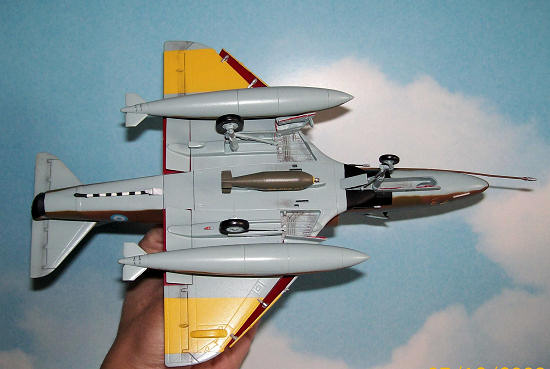 finally
reacted, he looked for the Harriers in the original position. It crossed his
mind the idea of attacking them but he remembered that his guns were jammed. The
Harriers were not at 3 o’clock anymore. One was now at 12 o’clock, above him,
and turning in his direction.
The Argentine proceeded to drop his entire external
ordinance and start maneuvers to avoid being shot down.
finally
reacted, he looked for the Harriers in the original position. It crossed his
mind the idea of attacking them but he remembered that his guns were jammed. The
Harriers were not at 3 o’clock anymore. One was now at 12 o’clock, above him,
and turning in his direction.
The Argentine proceeded to drop his entire external
ordinance and start maneuvers to avoid being shot down.
Dave Smith had not been able to
locate Morgan but saw the explosions of the two missiles and planes. Morgan, by
then, was trying to shot down Bolzan using his 30 mm Aden guns. His HUD was not
working and therefore he was not able to aim properly. Those splashes on the sea
showed Smith where the target was, and visually extrapolating backwards and
slightly to the left he then saw Morgan for the first time after their dive.
When he emptied his guns, Morgan shot upwards to return to HMS Hermes as he was
short of fuel. “Sharky” Ward and Steve Thomas from HMS Invincible 801 Sqn were
arriving to the area to take over the
Bolzan was looking for the island in
front of him and trying to evade the gun fire he was under, a term called “guns
jink”.
Almost out of range, running at
600 knots and no higher than 100 feet, Smith fired his missile. He was unsure if
he had fired his missile to the other Harrier
Sanchez was now flying very low,
maneuvering violently to shake off any potential enemy from his tail while
taking a southerly direction. He was looking for the sheets of rain in front of
him, as he knew that these could give him some sort of protection against the
Sidewinders.
Ward and Thomas were about to chase
the last Skyhawk when HMS Cardiff ordered them to climb to engage an Argentine
At that moment, the British dove away and the Argentine controller lost them in
the radar.
But Sanchez’s problems had not
ended. One of his drop tanks had not transferred all the fuel to the main tank
and now he did not have enough gas to retur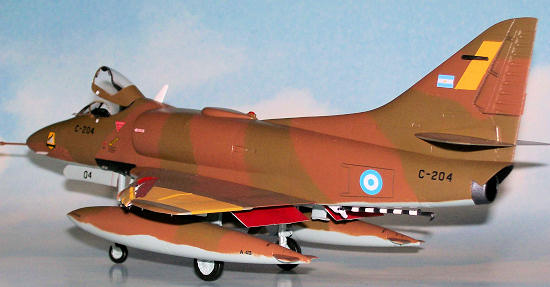 n
to the continent. After flying some minutes very low to evade any potential
enemy, he decided to climb to save fuel while he was calling the tanker to get
close to the Islands to save him. The commander of the KC-130 asked:
n
to the continent. After flying some minutes very low to evade any potential
enemy, he decided to climb to save fuel while he was calling the tanker to get
close to the Islands to save him. The commander of the KC-130 asked:
-“Give me your position”
-“I don’t have it”
-“Read it in your Omega”
-“I don’t have Omega”
-“Turn on your
-“I don’t have
This means that Sanchez aircraft had
only the minimum equipment. The plane with all the navigational aids in the
formation had been the leader’s, C-204.
The tanker (commanded by
Commodore Cano) got close to the island while loosing height, and Sanchez was
flying west, gaining height. Finally, the Hercules started to leave a
condensation trail as it changed to a colder air layer. Sanchez saw the trail
and turned towards his salvation. Flying too fast, he overtook the tanker and
had to turn very sharp to try again.
He was able to connect his probe to the tankers’
refueling basket. The commander of the KC-130 exclaimed: “You are safe!” but
they could hear Sanchez distressed voice saying: “No sir, it’s not worth it this
way. I have lost my 3 companions…” Having topped up his tanks, Sanchez returned
to Rio Gallegos safely, the only survivor of this mission.
The combat, from the moment the
Morgan spotted the planes until Bolzan was shot down, only lasted 90 seconds.
Bolzan was found by some locals and
buried in the same spot his plane had crashed, but later on he was taken to the
Argentine Cemetery in Darwin.
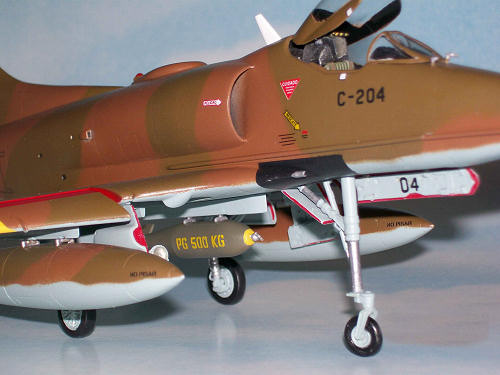 Vazquez
and Arraras were 2 of the 4 survivors of the 8 that attacked HMS
Glasgow and HMS Brillant on May 12th.
That means that out of the 8 that took part in that attack on May 12th,
only 2 survived the war (Zelaya and Dellepiane).
Vazquez
and Arraras were 2 of the 4 survivors of the 8 that attacked HMS
Glasgow and HMS Brillant on May 12th.
That means that out of the 8 that took part in that attack on May 12th,
only 2 survived the war (Zelaya and Dellepiane).
These kills made Dave Morgan the
top scoring pilot of the war with 4 victories, and the 2nd
and last kill for David Smith. These were also the last Sea Harrier victories in
the war.
I want to remark that there is
an important discrepancy between Sanchez and the Sea Harrier version of the
events, and that is that according to the Argentine pilot, both Harriers
initially fired a missile each and that these 2 Sidewinders impacted Arraras and
Vazquez (one kill for each). Then, as Morgan is awarded 2 claims, then he is the
one that would have shot down Bolzan. The British version of the events is that
Morgan fired 2 missiles first and that Smith shot down the 3rd
Skyhawk (Bolzan). Regretfully, both versions are irreconcilable at the
time of writing this article even though I have checked again with the
protagonists.
Foxtrot 4 sank that night, while efforts to tow
her to safety failed. The list of casualties is as follows:
Royal Marines
* Marine Robert D. Griffin
* Colour Sergeant Brian R. Johnson, QGM (from Foxtrot 4, Johnson had saved the
life of Argentine Pilot “Tom” Lucero from the cold waters of San Carlos when he
ejected from his damaged Skyhawk A4-C late in May)
* Sergeant Ronald J. Rotherham
* Marine Anthony J. Rundle
Royal Navy
* Marine Engineering Arfificer Alexander S. James
* Leading Marine Engineering Mechanician David Miller
As a postscript Dave Morgan and Hector Sanchez are now friends and have met in a couple of occasions, keeping in touch via email.
| THE KIT |
 This kit
was in fact built many years ago as C-222, the famous Tordillo. It was the only
all gray Skyhawk in service in the Air Force in 1982. When we moved to Canada I
brought all my model kits by ship, inside boxes full of Styrofoam. During
inspection at Customs, it looks like someone did not believe the description of
what was inside the boxes, opened some and broke several of the kits. One of
those was my Tordillo.
This kit
was in fact built many years ago as C-222, the famous Tordillo. It was the only
all gray Skyhawk in service in the Air Force in 1982. When we moved to Canada I
brought all my model kits by ship, inside boxes full of Styrofoam. During
inspection at Customs, it looks like someone did not believe the description of
what was inside the boxes, opened some and broke several of the kits. One of
those was my Tordillo.
It lost several critical pieces like: canopy, main landing gear, nose landing gear doors, main landing gear front doors, one main wheel, arrestor hook, some bombs, pitot tube, left slat and flap, an Omega antenna, landing light, some arms of the landing gear system…For a moment I thought about throwing it away or using it as spares. It stayed in that derelict state for many years.
| CONSTRUCTION |
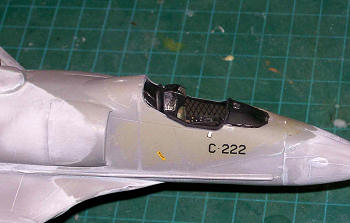 Some months
ago I decided to fix it, by making the missing parts using resin copied in
rubber casts. One thing I noticed is that the gloss varnish I had used to give
the plane a gloss coat of the decals had now yellow. It was Humbrol.
As now the entire plane had a yellowish hue, I also made
the decision to stick it in bleach to remove the paint. Sitting the plane on
different parts of a plastic container full of this solution, I avoided having
bleach entering the cockpit. So luckily there was no need to repaint the
interior! In this picture you can see the yellowed gray, the original base paint
without varnish and the gray plastic. Note the untouched interior and original
Tordillo decals.
Some months
ago I decided to fix it, by making the missing parts using resin copied in
rubber casts. One thing I noticed is that the gloss varnish I had used to give
the plane a gloss coat of the decals had now yellow. It was Humbrol.
As now the entire plane had a yellowish hue, I also made
the decision to stick it in bleach to remove the paint. Sitting the plane on
different parts of a plastic container full of this solution, I avoided having
bleach entering the cockpit. So luckily there was no need to repaint the
interior! In this picture you can see the yellowed gray, the original base paint
without varnish and the gray plastic. Note the untouched interior and original
Tordillo decals.
The dorsal Radome is a mix of the
original HC one and a part I had made in resin originally.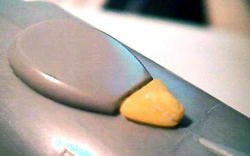
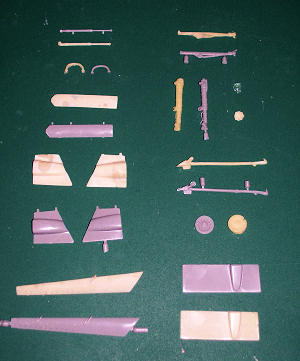 The
one-minute resin had the disadvantage that it dries too fast and does not run
everywhere, especially when the casts have complex shapes (i.e. front doors of
main landing gear). As a consequence, these were made up of up to 3 different
doors that were partials or had air bubbles. The nose landing gear had a corner
missing and I added some plasticard. I used a two-part plumber epoxy glue to fix
all the parts that required attention. Some areas in different color show the
epoxy.
The
one-minute resin had the disadvantage that it dries too fast and does not run
everywhere, especially when the casts have complex shapes (i.e. front doors of
main landing gear). As a consequence, these were made up of up to 3 different
doors that were partials or had air bubbles. The nose landing gear had a corner
missing and I added some plasticard. I used a two-part plumber epoxy glue to fix
all the parts that required attention. Some areas in different color show the
epoxy.
As there were some bubbles in the
new slat, I considered that a light gray color scheme would make them stand out.
So I picked a different plane to build. This was C-204, the last Skyhawk lost by
the Air Force in the war.
Once all resin parts were fixed
and cleaned, I glued the legs. The bomb supplied by HC (spares box) has the
wrong fins but overall the right shape. So I cut out the front of the fins (they
are square and not triangular like HC depics) and the bomb was ready. The
configuration of the plane is the one that Carballo used on May 21st.
| COLORS & MARKINGS |
Paint:
The undersides were the first
color, in RLM65 from MM Acryl. Then I moved to the top cammo with the red brown
(MM Acryl 4707).
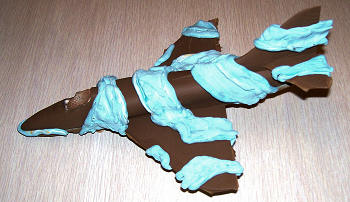 After
masking these colors with blutac, the green was sprayed using MM Acryl 4708.
After
masking these colors with blutac, the green was sprayed using MM Acryl 4708.
I left the red areas exposed. That was the next color, along with the black around the guns.
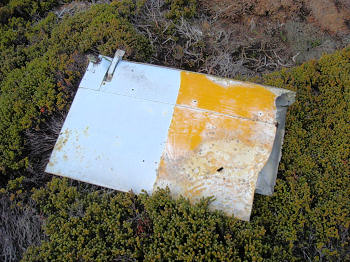 Finally,
the wing tips and tail were masked and the yellow ID bands were applied. These
ID bands were applied to all the Skyhawks just before May 1st
and later on some of those planes had them overpainted in dark brown. C-204 was
not the case, based on the clear pictures of the remains of the plane. These
pictures clearly show that the bands were ALSO painted under the wings.
Finally,
the wing tips and tail were masked and the yellow ID bands were applied. These
ID bands were applied to all the Skyhawks just before May 1st
and later on some of those planes had them overpainted in dark brown. C-204 was
not the case, based on the clear pictures of the remains of the plane. These
pictures clearly show that the bands were ALSO painted under the wings.
I added some stains here and there,
specially around the moveable surfaces (black pastel sanded and dry brushed).
These surfaces were also highlighted with a very sharp pencil.
With a brush I painted the red rims
of the landing gear doors. The arrestor hook was painted in bands of white and
black.
Three or four coats of Future sealed
the colors and pastels and then I applied the decals.
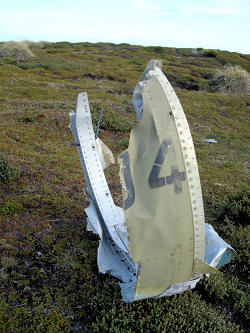
Decals:
Serial numbers and the flags on the
tail came from a HC sheet that I had left from other Skyhawks I had previously
assembled. Roundels, stencils (including the one for the Mk-17 nicknamed the
bombola by the pilots as it was a mix of bomb and ball/rock) came from
Aerocalcas.
But one thing that I did not have was the “4” for “204”. So I took them from the Carpena decal sheet, which has black numbers (Sheet # 48.38a).
| FINAL CONSTRUCTION |
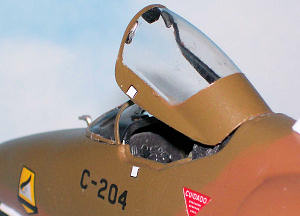 Tanks were
glued in place, along with doors, hook, rest of landing gear and wheels, guns,
VHF and Omega antennas, bomb, top ejection handle (original, I still don’t
understand how it did not get lost with many other parts), slats and flaps.
Tanks were
glued in place, along with doors, hook, rest of landing gear and wheels, guns,
VHF and Omega antennas, bomb, top ejection handle (original, I still don’t
understand how it did not get lost with many other parts), slats and flaps.
The entire plane was given a coat of
satin varnish.
Two pitot tubes were scratch built and painted. I made a new gunsight and glued two mirrors to the canopy (it is a vacuum canopy made by Falcon). Codes are #53 for Falcon and True Details 48710 for the mirrors. With this, I glued the canopy in place and the kit was finally finished (or restored!)
| CONCLUSIONS |
Most of my friends tell me that they
would have thrown it away or used it for spares. I am glad that will some extra
work I was able to recuperate this kit, and now I can use the Hasegawa A4-B to
make the Tordillo some day.
Thanks to:
Hector Sanchez and David Smith
for their extensive contribution and all the time they dedicated to try to get
the historical part of the text as accurate as possible.
Exequiel Martinez for his painting, Allan White for the pictures of crashed C-204, Pablo Carballo for his support and finally to Steve Thomas for sharing his experiences.
| REFERENCES |
Hostile Skies, Dave Morgan
Falklands Air War, Chris Hobson
Los Halcones no se lloran, Pablo
Carballo
Dios y los Halcones, Pablo Carballo
Guerra Aerea en las Malvinas,
Benigno Andrada
A4-B Skyhawk, Nunez Padin
Historia Oficial de la Fuerza Aerea Argentina, volume VI, book 1 and 2
If you would like your product reviewed fairly and quickly, please contact me or see other details in the Note to Contributors.